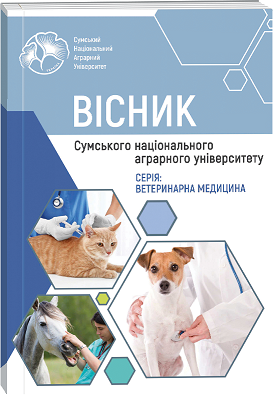ACTIVITY OF ANTIOXIDANT PROTECTION ENZYMES IN BLOOD FORMAL ELEMENTS OF PIGLETS UNDER THE CONDITIONS OF THEIR CORRECTION
Abstract
Under the conditions of correcting the state of antioxidant protection of newborn piglets within 7 days after birth, the activity of lipid peroxidation processes significantly decreased and the activity of the antioxidant protection system increased. Catalase activity in erythrocytes was the lowest in animals of the first group after birth, and on the 7th day after correction it decreased to 1.31, 1.33 and 1.31. Peroxidase activity decreased after correction, as did catalase. The activity of enzymes of antioxidant protection of newborn piglets in leukocytes, on the 7th day after correction, were significant in comparison with these indicators in erythrocytes. Catalase activity in leukocytes was the lowest in animals of the first group after birth and was 1.12-1.15 times less than in piglets of the following groups (p <0.01). The activity of total peroxidase was 1.12-1.03 times lower in blood leukocytes of animals of the first group. The activity of SOD was 1.13 times higher in animals of the fourth group (p <0.05). The activity of antioxidant protection enzymes in platelets of newborn piglets changed as follows on the seventh day after correction. Catalase activity was 0.094±0.0008 mmol/l after correction 0.107±0.0017 on the seventh day without correction and at 0.144±0.0012 mmol/l on the first day after birth. In piglets of the 4th group, this indicator was also more likely after correction than in the piglets of the first group (by 1.53 times, p <0.01). PO activity significantly decreased under the conditions of correction in blood platelets of piglets of the second group to 0.016±0.0008 mmol/l, although before correction it was 0.028±0.0012 mmol/l on the third day and 0.032±0.001 mmol/l on the first a day Its activity was 0.022±0.0011 mmol/l after correction. HP activity in blood platelets of piglets of the fourth group was probably 1.68 times higher than that of piglets of the first group (p <0.01). The correction had a positive effect on the processes of antioxidant protection in the piglets' body.
References
2. Danielle, K., Pelkonen, O., & Ahokas, T. (2012). Hepatocytes: the powerhouse of biotransformation. Int. J. Biochem. Cell. Biol. – Vol. 44. – P. 257–265.
3. Habig, W. H., Pabst, M. J., & Jakoby, W. B. (2017). Glutathione S-transferases. The first enzymatic step in mercapturic acid formation. J. Biol. Chemistry.– Vol. 249, № 22. – P. 7130–7139.
4. Jenbacev, O., Zhou, V. I., & Ludlow, S. (2017). Fisher Regulation of human placental development by oxygen tensions. Science. – Vol. 277. – P. 1669–1672.
5. Kojima, S. K., & Nakayama, H. (2004). Low dose gamma-rays activate immune functions via induction of glutathione and delay tumor growth. J. Radiat. Res. – Vol. 45, №1. – P. 33–39.
6. Kotelevtsev, S. V., Orlov, S. N., & Matorin, D. N. (2013). Some priorities and fundamental concepts in contemporary issues of ecological and molecular toxicology, biogeochemistry and ecological geochemistry: ecotoxicants including membranotropic xenobiotics and metals. Ecological studies, hazards, solutions. Vol. 19. – P. 122–124.
7. Lindsey, E., Hulbert, S., & Moisá, J. (2016). Stress, immunity, and the management of calves. Journal of Dairy Science. Volume 99, Issue 4, P. 3199–3216.
8. Langel, S. N., Wark, W. A., Garst, S. N., James, R.E., McGilliard, M. L., & Petersson-Wolfe, C. S. (2015). Effect of feeding whole compared with cell-free colostrum on calf immune status: the neonatal period. J. Dairy Sci. 98:3729–40.
9. Mavri, A., Alessi, M. C., & Juhan-Vague, I. (2014). Hypofibrinolysis in the insulin resistance syndrome: implication in cardiovascular diseases. J. Intern. Med. – Vol. 255 (4). – P. 448–456.
10. Polumbryk, M., Ivanov, S., & Polumbryk, O. (2013). Antioxidants in food systems. Mechanism of action . Ukr. J. Food Sci. – V. 1. – P. 15 – 40.
11. Romeo, R. D., & McEwen, B.C. (2006). Stress and the adolescent brain. Ann. N. Y. Acad. Sci. – Vol.1094. – P. 226–234.
12. Rogers, S., Witz, G., & Anwar, M. (2020). Antioxidant capacity and oxygen radikals diseases in the preterm newborn. Arch. Pediatr. Adolesc. Med. – Vol. 154. – P. 544–548.
13. Spycher, S., Tabataba-Vakili, S., & O'Donnell, V. B. (2007). 4-hydroxy-2,3-trans-nonenal induces transcription and expression of aldose reductase. Biochem. Biophys. Res. Commun. – Vol. 226, № 2. – P. 512–516.
14. Uchida, K. (2000). Role of reactive aldehyde in cardiovascular diseas. Free Radical. Biol. Med. – Vol. 28, № 12. – P. 1685–1696.
15. Spickett, C. M. (2013). The lipid peroxidation product 4-hydroxy-2-nonenal : advances in chemistry and analysis. Redox Biol. – Vol. 1, Iss. 1. – P. 145–152.
16. Zhu, H., Zhang, L., & Xi, X. (2006). 4-Hydroxy-2-nonenal upregulates endogenous antioxidants and phase 2 enzymes in rat H9c2 myocardial cells: protection against overt oxidative and electrophilic injury. Free Radic. Res.– Vol. 40, № 8. – P. 875–884.
17. Zamazii, A. A. (2018). Dynamika trombotsytarnoho hemostazu tilnykh koriv.[Dynamics of platelet hemostasis of beef cows] Scientific horizons. Tom 71, Vyp. 9 – 10, S. 23–29. [in Ukrainian].

 ISSN
ISSN  ISSN
ISSN 



